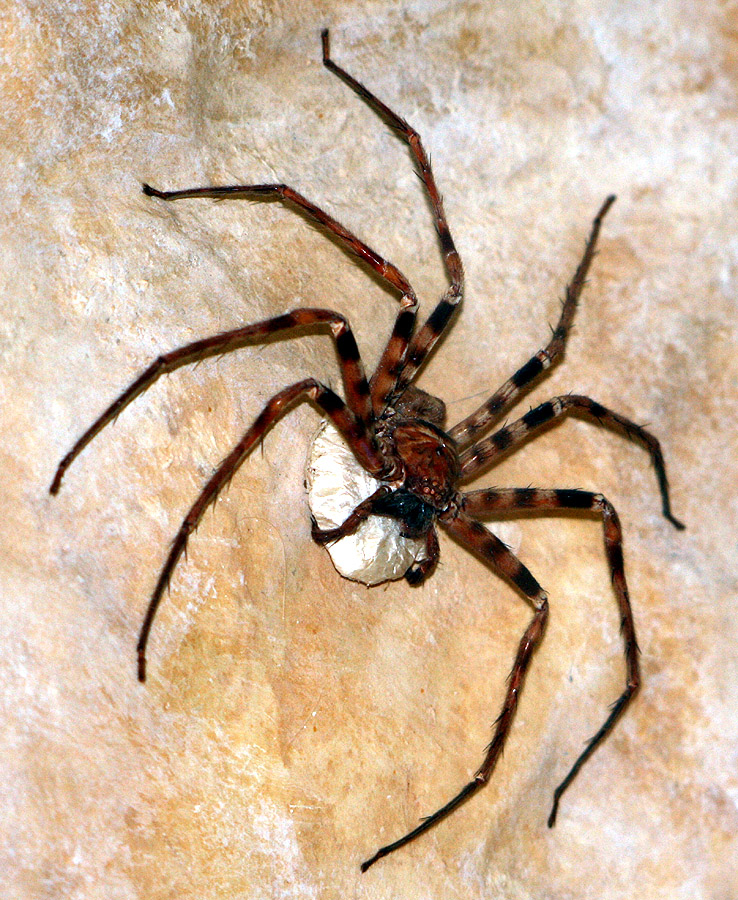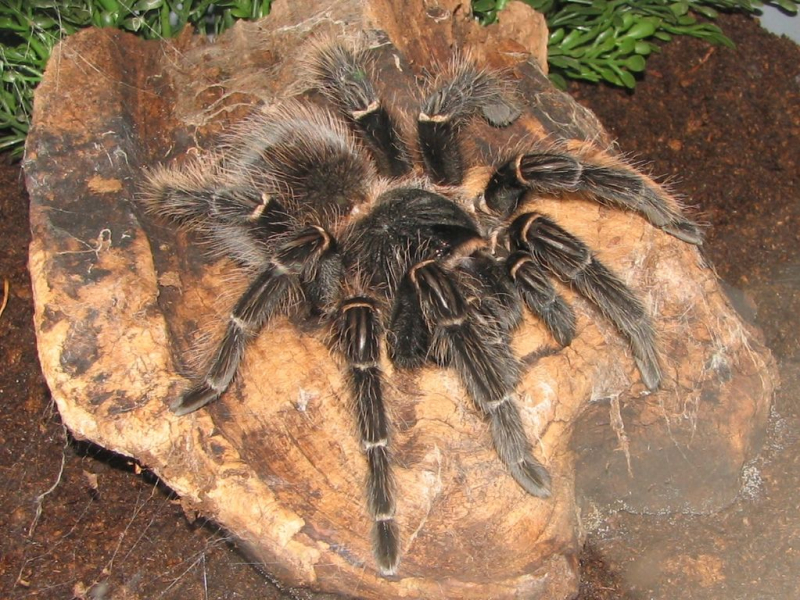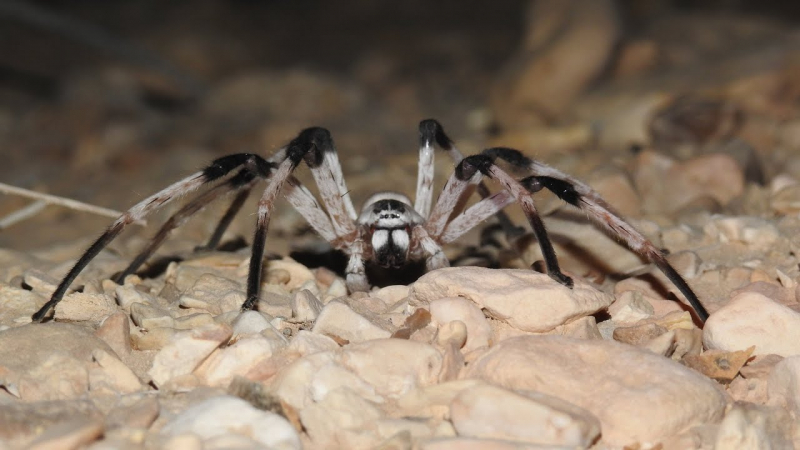Top 10 World's Biggest Spiders
Spiders are insects with several legs and eyes. They typically have eight legs and eight eyes, some of them are very colorful and come in a variety of shapes ... read more...and sizes. In order to catch prey and survive, certain spiders have evolved to construct webs between trees, walls, etc., while others live in ground-level burrows and chase creatures using venom and agility. Here is a list of the biggest spiders in the world, let's find out!
-
The Giant Huntsman Spider (Heteropoda maxima) is a species of the huntsman spider family Sparassidae found in Laos. Because of its pale coloring, lengthy legs, and distinctive hairs on the male spider's second foot, the giant huntsman spider, is thought to be a cave dweller. The species may live close to cave entrances because there is no obvious decrease in the eyes.
On the back half, the coloration is yellowish-brown with a few erratically spaced dark dots. Before the initial bend, the legs have broad, black stripes. Like all huntsman spiders, the huge huntsman spider has lengthy, body-to-leg ratio legs that bend forward like crabs. In addition to size, the H. maxima can be identified from other Heteropoda species by its genital features. The cymbidium in males exceeds the tegulum by a factor of at least three. The morphology of the female's epigyneal field, which has two anteriorly directed bands, and the path of her internal ducts serve as distinguishing features. The enormous huntsman spider, with a leg span of 30 cm (12 in) and 4.6 cm, is the largest member of the Sparassidae family (1.8 in) body length.

Wikimedia 
Wikipedia -
The Goliath Birdeater (Theraphosa Blondi) belongs to the tarantula family Theraphosidae. In contrast to what their name suggests, this species prefers to consume mice, frogs, lizards, and other small animals. These venomous, aggressive spiders originate from South America. Instead of fleeing when attacked, they crouch on their back legs and expose their fangs, appearing to challenge the assailant to a duel.
It is the largest spider in the world by mass (175 g, 6.2 oz), body length (up to 13 cm, 5.1 in), and leg span (second to the giant huntsman spider), all of which are found in northern South America. One of the rare tarantula species, the birdeater, does not have tibial spurs, which are found on the first pair of legs of most adult males. Most of them are golden-hued and tan to light brown in color. In contrast to other spiders/tarantula species, females do not consume the males during mating. Females take 3–6 years to reach sexual maturity, and they live for 15–25 years on average.

American Association for the Advancement of Science 
Monster Bug Wars -
The Brazilian Salmon Pink Bird-Eating Tarantula, often referred to as the salmon pink or LP, is a tarantula native to northeastern Brazil. In 1917, Cândido Firmino de Mello-Leito discovered and described it in Paraba, where the tarantula is native. They are well-liked pets in the tarantula hobby due to their size and propensity for reproduction. They are also regarded as being "docile".
Since males' legs are longer than those of females, the salmon pink bird-eater can grow to have legs up to 11 inches long. Females, on the other hand, can weigh more than 100 grams. Males typically have slim bodies, whilst females frequently have big bodies relative to their legs. The front pair of legs of mature males will also have tibial hooks, which are used to pull a female's fangs back during mating. When fully grown, they exhibit pink-red hairs along the legs, chelicerae, and abdomen; the colors tend to be more vivid in the males. They have a uniform black color and are commonly regarded by pet sellers as an aesthetically beautiful tarantula species.

Wikipedia 
Reptile Range -
Grammostola Anthracina is a species of spider belonging to the family Theraphosidae (tarantulas). It is found in Uruguay, Paraguay, Brazil, and Argentina. They prefer to reside in scrubs, desert regions, and grasslands, just like other tarantulas do. Despite their gorgeous red appearance, size, and behavior, which make them quite popular among spider petters, it is nevertheless advisable to avoid handling them because their bite can sting very badly. The typical diet of moths, grasshoppers, lizards, cockroaches, mealworms, etc. is also part of their diet.
The body of Grammostola anthracene is completely brown, and females have lengthy spermathecae with a rounded apex. A female's body is around 45 mm long, with the fourth (final) leg being the longest at 60 mm. Stridulatory hairs can be seen on the first leg's coxa's forward-facing side. On the top surface of the abdomen, there are irritating hairs of types III and IV. The genus Grammostola is distinguished by its spermathecae, stridulatory hairs, and urticating hairs.

EcoRegistros 
Wikimedia Commons -
Poecilotheria Rajaei is a tarantula in the genus Poecilotheria endemic to Sri Lanka. The name Poecilotheria is derived from Greek: "poikilos", meaning spotted, and "therion", meaning wild beast. Its food comprises prey that is frequently larger than this animal's length, such as birds, lizards, rodents, and snakes.
The spider features vibrant yellow and gray striping on its first and fourth legs and a pink abdomen band. Its legs can extend up to 20 centimeters (8 in) in length. It prefers to reside in old-growth trees, but because of destruction in its post-war habitat, it is now more likely to inhabit outdated structures. The venom of P. rajaei can kill small rodents, birds, lizards, and snakes but is not fatal to humans. The newly discovered tarantula's exact rarity is unknown, however, there is some worry that habitat loss is causing their population to decline.

Wikipedia 
Spider Identifications -
The Hercules Baboon Spider (Hysterocrates Hercules), a venomous tarantula that is located in a few nations on the African continent, notably Nigeria, is one of the most terrifying species in the Animalia kingdom. Due to the fact that the last specimen was discovered 100 years ago, it is thought that these tarantulas may be extinct. At the moment, this specimen is kept in London's Natural History Museum.
These enormous tarantulas can be found in savannah forests, dry scrublands, and grasslands. They often live in burrows. These spiders build a deep shelter in arid locations to shield themselves from the intense heat. Insects, bugs, and small spiders are the main prey of hysterocrates hercules spiders. The most common colorations of these spiders are either black or brown, and they have hair all over their bodies. They have long, baboon-like legs, spotted multicolored markings on their abdomen, and glowing bands on their carapace. To show their teeth, they typically extend their front legs to the side. They have a larger carapace than the majority of other African spider species, and their leg reach measures 8 inches.

Alex21C 
Kidadl -
The Colombian Giant Tarantula or Colombian giant redleg, has a span of 6 to 8 inches, and was first described by Anton Ausserer in 1875. They can be discovered in the tropical rainforests of Brazil and Colombia. This region experiences 2,500mm of annual rainfall on average, and daily highs typically exceed 23°C. Animals like the glass frogs and flora like the Lance-tailed manakin live there, as well as plants like Cavanillesia platanifolia.
The Columbian Giant Tarantula's brilliant red body and roughly 20 cm long, hairy legs speak volumes about it. The leg's bright bands appear to serve as a warning to nearby species. This giant spider is typically quite aggressive and attacks with its hind legs because of its massive body. It survives by eating anything it can catch, such as lizards, insects, mice, etc.

Wikipedia 
Diamond Painting -
The aggressive and extremely deadly Brazilian Wandering Spider (Phoneutria fera). Brazil is where it got its start, therefore the name. However, other members of this genus have been found in South and Central America. The Ctenidae family of wandering spiders includes the Brazilian Wandering spider. Because it is the most deadly animal, the Brazilian Wandering spider was listed in the 2007 Guinness Book of World Records. There are five comparable species in this particular genus that are likewise quite venomous. They include some of the comparatively rare spider species that are dangerous to people.
The leg span of the Brazilian wandering spider can increase to 4 to 5 inches. They are huge, hairy spiders with a spindly appearance, and they have eight eyes, including two large eyes. Brazilian wandering spiders move quickly, have strong, spiny legs, and striking red fangs that they flash when agitated.

Live Science 
Freepik -
A huntsman spider called Cerbalus Aravaensis can be found in the southern Arava Valley of Israel and Jordan. The spider is the largest Sparassidae member in the Middle East, with a limb span of 14 centimeters (5.5 in). Body length for men is 1.85-2.40 centimeters (0.73-0.94 in), while it is 2.20-2.65 centimeters (0.87-1.04 in) for women. This huntsman spider species is extremely uncommon. Currently, efforts are being made worldwide to protect this threatened species. They are thought to have become extinct due to farming and quarrying. Their legs are covered in tiny hairs, and they have a body that is both white and black in hue.
Sand dunes and partially firm sands at the edge of salt marshes are the habitats of Cerbalus aravaensis. It is nocturnal and most active during the sweltering summers. In order to hide the entrance from predators, it builds underground nests with hinged, trap-door-like operculum constructed of sand and glue.

Ynetnews 
Pinterest -
Arachnids of the order Solifugae are also referred to as camel spiders, wind scorpions, sun spiders, or solifuges. In roughly 147 genera, the order has more than 1,000 recognized species. The majority of Solifugae species are opportunistic feeders that graze on tiny animals and ground-dwelling arthropods in dry areas. The length of the legs for the largest species is 12–15 cm (5–6 in). Numerous urban legends overestimate the Solifugae's size, speed, and minimally dangerous capacity for harming humans.
Typically, the Solifugae are univoltine (reproducing once a year). Indirect sperm transfer occurs when the male discharges a spermatophore onto the ground and subsequently inserts it with his chelicerae into the female's genital pore during reproduction. He throws the female on her back to accomplish this. After that, the female excavates a tunnel, where she deposits 50 to 200 eggs, some species of which guard the eggs until they hatch.

Wikipedia 
Wikimedia Commons




























